Church History
The church building and its history
The Village of Farnham
The name ‘Farnham’ comes from the ancient name ‘Phernham’, meaning the village of the fern. There has probably been a settlement here since the Neolithic period. Many place names in Farnham have survived little changed since the 13th century and the village is made up of several small hamlets. Hazel trees grew in abundance and so we have Hazel End as well as Chatter End, Farnham Greem and Levels Green, which all make up the village of Farnham.
History, architecture and provenance
There has been a church on this site since 1247, but information about this early period is very sketchy. However, there is now hanging in the north aisle a recently discovered roll of rectors which has been restored and provides some help in the dating. The previous church was considered to be on the verge of decay and so in 1857 it was decided to build a new one.
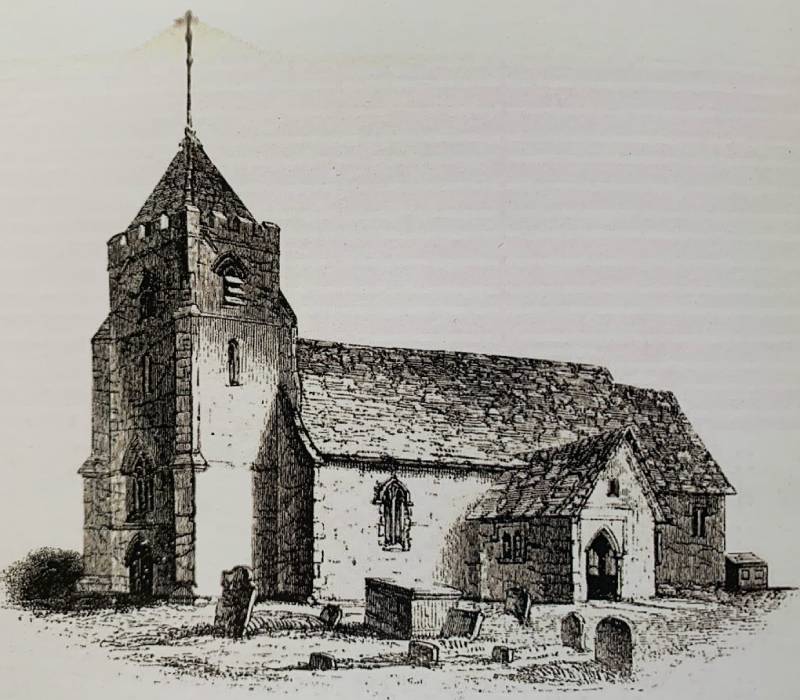
An artist’s impression of the original church
Joseph Clarke, the diocesan architect, supervised the construction and the builder was Charles Foster of the Whitefriars Company. The design, which was similar to that of the old church and built on the same site, is one of the finest examples of a typical Victorian church. The church was built of solid brickwork and faced with a mixture of stones, mainly flint.
The stone is from the limestone quarries in Ancaster. A curious feature is a clay pipe embedded between the flints on the south side of the chancel. The story goes that it belonged to one of the labourers who was discovered smoking on the job!
On the south side there is a porch and at the west end there stands a massive battlemented tower with a pyramidal roof.
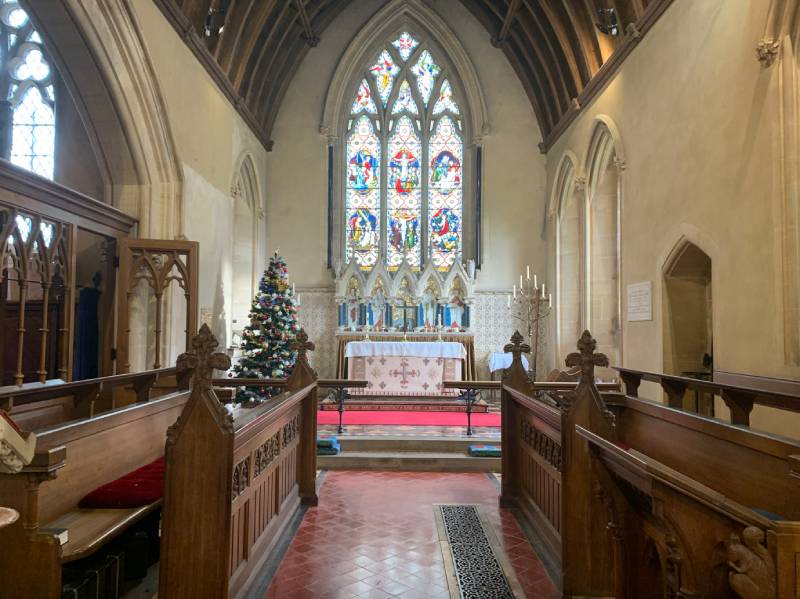
The choir, chancel and sanctuary
In 1840, the Reverend Copeland was appointed curate to John Henry Newman who was the leader of the Oxford movement, which argued for the return of some older Christian traditions of faith and their inclusion into Anglican liturgy and theology. Newman later left the Church of England to join the Roman Catholic Church. He became a cardinal in 1879 and was blessed by Pope Benedict XVI in 2010. Copeland was a close friend and confidant of Newman. He was deeply involved in the Oxford movement and it was only ill health in his later years whilst rector of Farnham that prevented him from writing an authentic record of those searching theological times. However, whilst rector, he did a great service to theology by editing the new edition of Newman’s Parochial Sermons. We know too that Newman visited Copeland whilst he was rector at Farnham. From ‘The Letters and Diaries of John Henry Newman’, volume 21, is the following:
‘The Oratory, Birmingham: June 4th, 1865.
My dear Rogers, I shall rejoice to see Church. As we have put off the Hursley expedition, I shall have Copeland alone in his nest at Farnham…
Ever affectionately,
John H Newman’
Considering all this, it is highly likely the design and ethos of the present church was significantly influenced by the Oxford movement. Indeed, to recognise Newman’s link to Farnham through Copeland, a special service of choral evensong was held in the church to mark the beatification of Newman by Pope Benedict XVI in 2010.
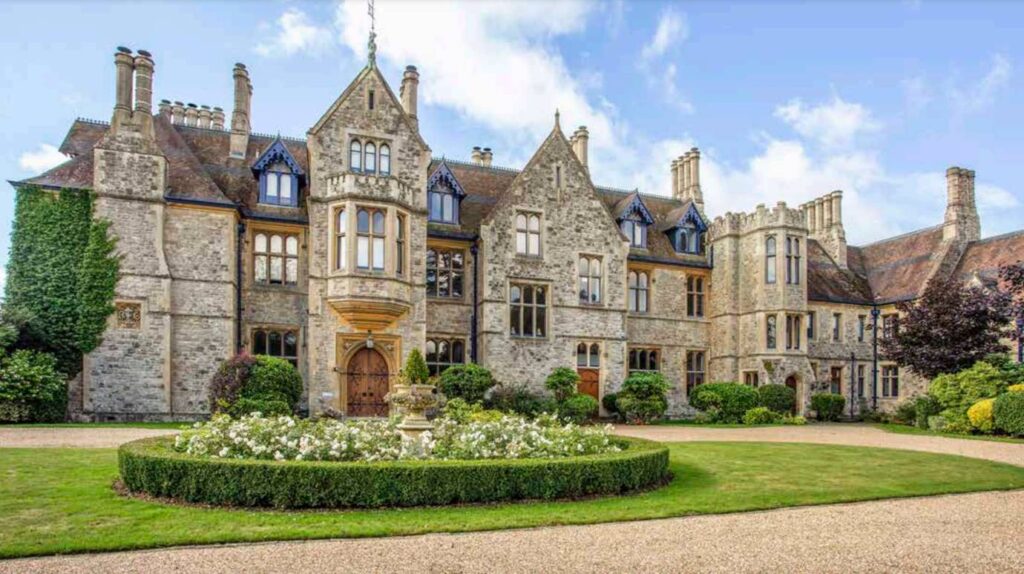 Overlooking the church across the valley of Bourne Brook is Hassobury Manor. There is an entry in the Domesday Book (1086) relating to the Manor of Hassobury and it seems probable, considering its proximity to the site of the church, that there has been a close association between the church and the successive owners of the Manor.
Overlooking the church across the valley of Bourne Brook is Hassobury Manor. There is an entry in the Domesday Book (1086) relating to the Manor of Hassobury and it seems probable, considering its proximity to the site of the church, that there has been a close association between the church and the successive owners of the Manor.
At the close of the sixteenth century, it was in possession of Henry Glasscock and it remained in the Glasscock family until 1746. The Glasscock entries in the Farnham parish registers cover a period of about 200 years from 1561 to 1746. In 1773, the Manor was sold to Mr William Gosling. The Gosling family were bankers and Gosling’s was a historical English bank located at least since 1743 at 19 Fleet Street, London, and identified by a hanging signboard depicting three squirrels. It now forms part of Barclays Bank. In 1868 the old manor house was pulled down and a handsome mansion was built close to the original site by Captain R Gosling, son of Robert Gosling, the first patron of the new church. Patronage of the church still remains with the Gosling family. Hassobury Manor and its farm outbuildings now provide houses for some 26 private residences.
The chancel, reredos and altar
The chancel is covered with an oak roof with ribbed rafters. The floor is decorated with coloured Minton tiles.
The reredos – the screen behind the altar – is made by William Farmer, an eminent Victorian sculptor. He and his partner William Brindley made the reredos in Worcester Cathedral. The reredos has five panels separated by six shafts of serpentile marble and was infilled with mosaics and ‘opus sectile’ work in 1890. The subject is the four evangelists and the Agnus Dei, designed by William Powells and sons of the Whitefriars company, which was particularly famous for innovative glass making. This beautiful reredos was made in 1890 and donated by Robert Gosling in memory of the Reverend W J Copeland, who was the rector for thirty six years from 1849 to 1885.
The altar frontal was restored by a team of local needlewomen. It took four years and was completed in 2009.
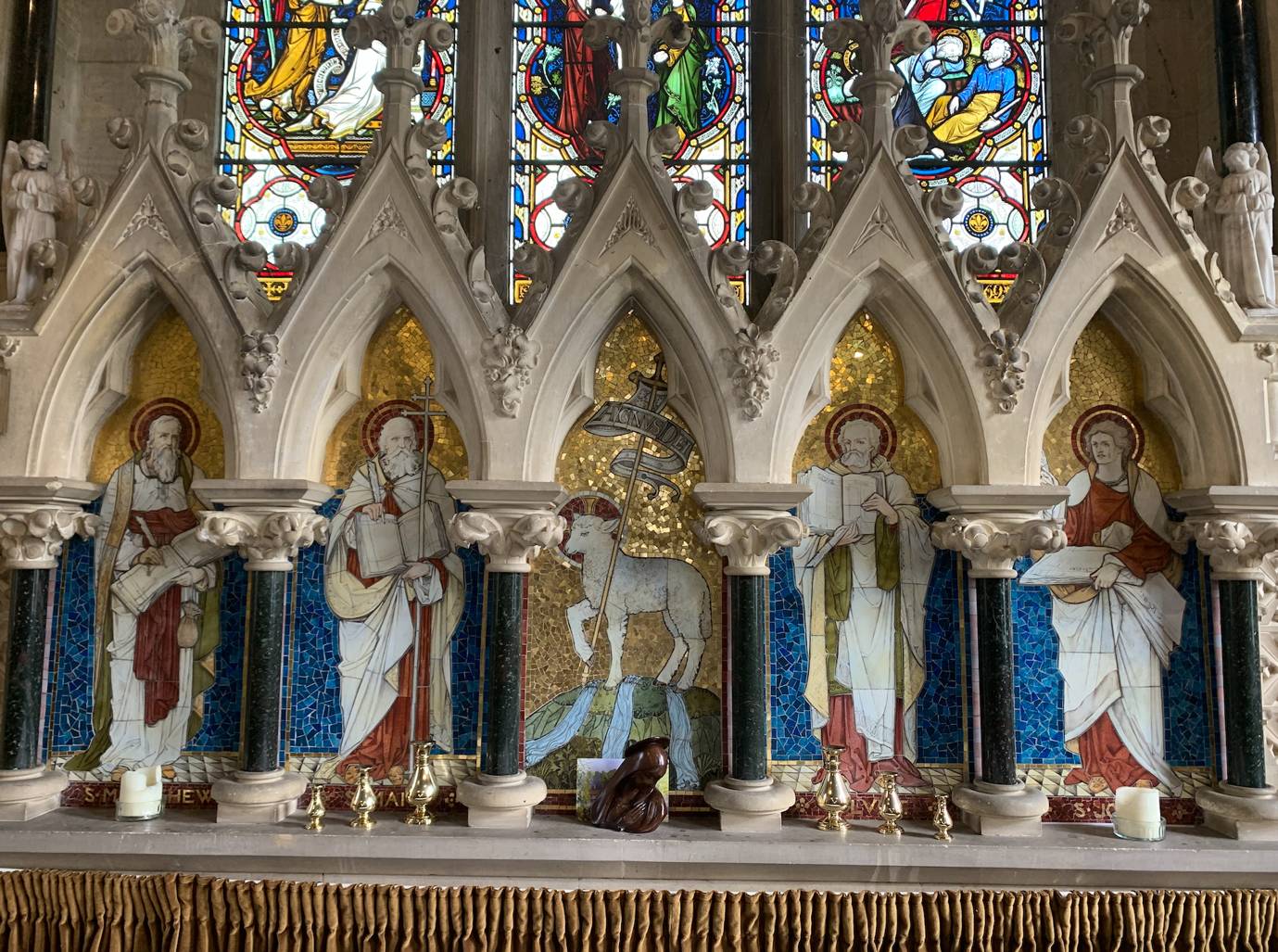
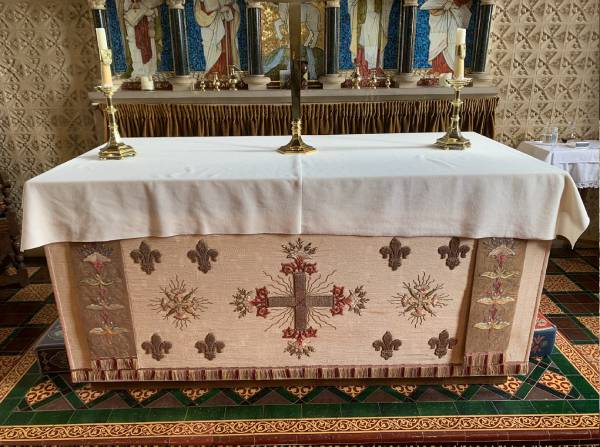
The desk, an altar cross, candlesticks and an oak sanctuary chair were all gifts from various parishioners. The inscription around the altar is, ‘I will wash mine hands in innocency, O Lord, so will compass thine altar’ (Psalm 26:6).
In 1957, a new rector’s stall, designed by John Pym, was donated by Col W D Gosling to commemorate the life of William Sullivan Gosling. The low screen that surrounds the stall incorporates a squirrel which is part of the coat of arms of the Gosling family and Gosling’s bank.
The chancel is separated from the nave by a low stone wall which incorporates both the lecturn and pulpit. Both are decorated with columns of Darlington marble and red and green serprentine and Cornish soapstone from Polyphant.
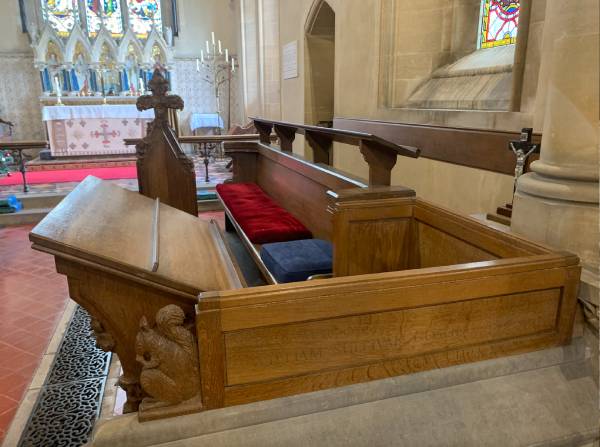
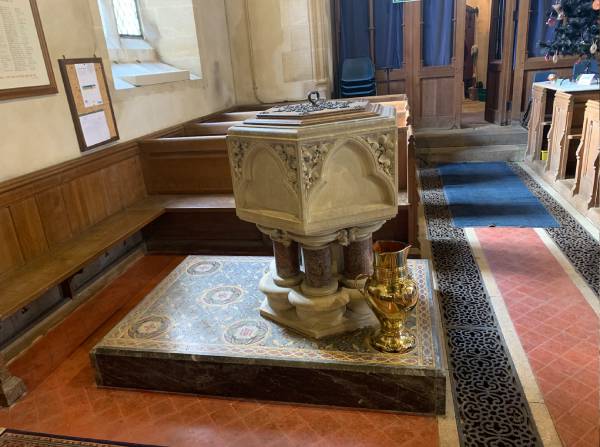
The Font
Six small Devon marble shafts support the foliage carvings surrounding the font. At the base is a brass plaque which states that in 1909, to celebrate the 50th anniversary of the consecration of the church, the font was enriched by a floor of Italian mosaic and by the addition of a brass ewer and cover. This was designed by the Reverend Ernest Geldart who was formerly rector of Little Braxted near Witham in Essex. He was a pupil of Alfred Waterhouse, a leading Victorian architect, who designed the Natural History Museum in London. Geldart later became architectural advisor to the Duke of Newcastle and also became famous for his beautifully designed vestments and spectacular reredos in St Cuthbert’s church in Earl’s Court, London.
The windows
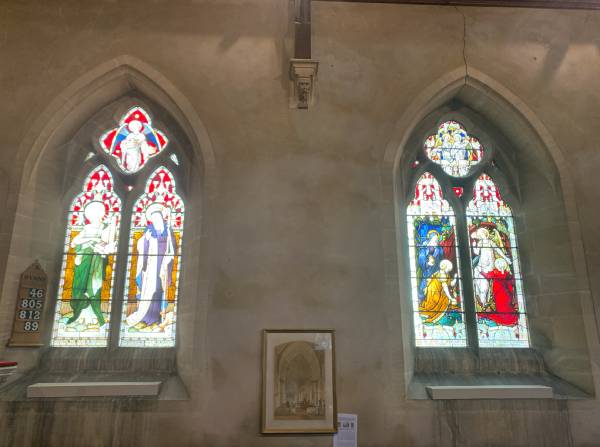
Stained glass windows have been installed over the years, mostly made by John Hardman & Co of Birmingham. John Hardman Snr was a close friend of, and greatly influenced by, Augustus Welby Pugin, a hugely influential Gothic revival architect. His nephew, John Hardman Powell, a member of the firm, married Pugin’s daughter. Pugin is known particularly for his work on the external detail and internal fittings of the Houses of Parliament.
The six windows are all memorials to the Gosling family. The large east window is dedicated to the memory of Robert Gosling (1795-1869) who subscribed the majority of funds for the rebuilding of the church. The life of his son, also Robert Gosling (1831-1895), is commemorated in a window in the south nave. He was a churchwarden at the time of the laying of the foundation stone of the new church and for a further thirteen years at differing times. In the north aisle there is a window dedicated to Robert Cunliffe Gosling (1868-1922). He was the eldest son of Robert Gosling’s sixteen children and was appointed High Sheriff of Essex in 1902, and took over as churchwarden when his father died in 1895. The window at the east end of the north aisle is dedicated to George Bennet Gosling (1872-1906), who was Robert’s fourth son by his second wife. The inscription on the brass plate underneath the window describes how George died of blackwater fever whilst on expedition in central Africa. He was a Captain in the Rifle Brigade and there is also a plaque to his memory in Winchester Cathedral. The window in the south side of the chancel is dedicated to John Hobart Gosling (1879-1880) who was the son of Robert Gosling’s second wife. The south nave window, alongside the pulpit, is dedicated to Robert’s first wife Mrs Cecil Mary (1833-1859) and their daughter Cecil Edith Gosling (1859-1889). As Cecil Mary died on the same day that Cecil Edith was born, it seems likely she died in childbirth.
In the east window of the vestry hangs a small stained glass panel representing St Basil the Great, which has recently been restored. This lovely glass panel came from the old church. It was purchased in Ghent, Belgium, for £15, by the then rector, the Reverend William Greenhill. He did a great deal for the old church, largely at his own expense. Greenhill also built the original Rectory House and laid out its gardens. This is now called Thrimley House, and has been a private dwelling since 1953.
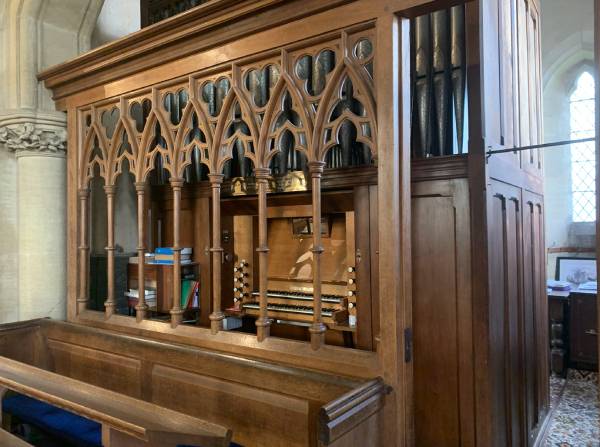
The Organ
The original small chancel organ, made by H Willis, was sold to Thornhaugh Parish Church in Peterborough for £20. It was replaced in 1890 by an instrument that was built by Henry Jones and Sons of South Kensington and cost £260. The brass plate on the front is inscribed with a dedication to Cecil Edith Gosling, Robert Gosling’s daughter, who died in 1889. The organ has been converted to electric power, but it can still be hand pumped if necessary.
The organ was thoroughly restored in 2007 and is cited in the National Organ Register in Birmingham.
The Bells
It is believed that five of the six bells present today came from the old church. They were made in the Colchester bell foundry of the Miles Graye family. There were three generations of Grayes and they were famously known for casting many bells for East Anglican churches. The older Graye died in 1649, and it is said that both he and the foundry suffered badly in the Siege of Colchester. The fifth bell is dated 1625, the fourth 1615, the treble 1618. The second and third bells were cast later by G Mears at the Whitechapel Bell Foundry, which also made the famous American Liberty Bell. The large tenor bell, also cast by G Mears, was added on 23rd July 1859 to make a peal of six. The peal of six is popular with bell ringers and the bells are still frequently rung.
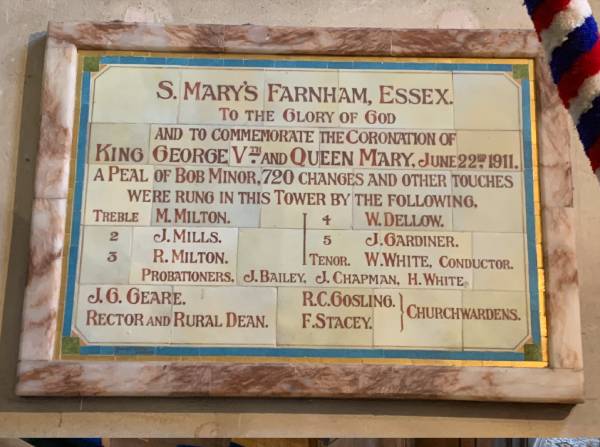
Other Notable Features
All the pews in the church are made of oak which has been carefully rubbed and bees-waxed and are not varnished. Of special note, at the east end of the north aisle are three lines of pews that have been especially designed to seat children.
In the bell tower are some memorial stones from the old church. The oldest is inscribed to Henry Lilley who was an ‘Officer of Arms 1638’. Also there is a monument to Revered William Greenhill, who was rector for 23 years until his death in 1849.
The churchwarden’s wands are dedicated to Eleanor Spencer Gosling (1839-1932), second wife of Robert Gosling, and Ethel Georgina Gosling (1881-1943), daughter of Eleanor and Robert Gosling.
The Churchyard and War Memorial
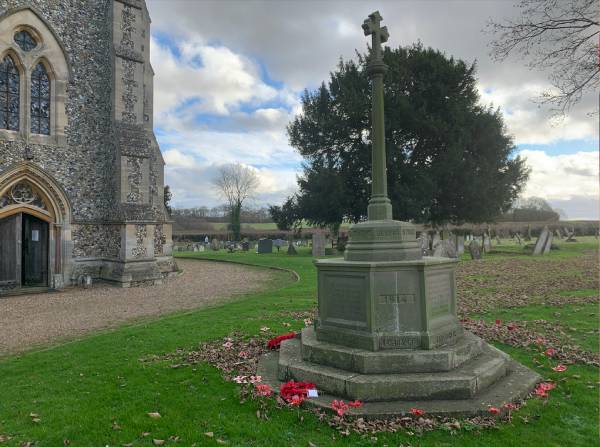 Even today, many of the local families still bear the same surnames as those on the war memorial sited near the west entrance to the church. This memorial was erected in memory of the men of Farnham who gave their lives in the Great War and was unveiled by Col S F Gosling in 1920. The service was conducted by the Reverend J G Geare MA, whose memorial is in the chancel.
Even today, many of the local families still bear the same surnames as those on the war memorial sited near the west entrance to the church. This memorial was erected in memory of the men of Farnham who gave their lives in the Great War and was unveiled by Col S F Gosling in 1920. The service was conducted by the Reverend J G Geare MA, whose memorial is in the chancel.
The names of those who died in World War II have been added. The cross at the top of the memorial was missing for some years following some damage and was replaced in 2004. The Parish Council is responsible for maintaining the War Memorial and a service is held annually on Remembrance Sunday to commemorate those who gave their lives in the two wars. The lives of each of these men have been researched by a parishioner, Ian Pinder, and form a book, ‘In Memory of Farnham’s War Dead’, written by him, and ‘dedicated to the memory of the ordinary men of this village who did extraordinary things and laid down their lives for King and Country.’
From an ancient account from William Greenhill (rector 1825-1849), there is mention of the churchyard. ‘The row of limes on ye north side of ye Churchyard, ye three elms in ye South-West corner and ye two Yews on ye South Side, were planted on Thursday, March 15th 1827’. The two yews are still standing as are most of the limes.
Greenhill also relates that in 1832, ‘a Vault was this yeare made on ye North Side of ye Churchyard, at ye request of William Gosling Esq., as Burial Place for himself and Family.’
The oldest existing gravestone in the churchyard is near the south east corner of the church, now disturbed by a large holly tree, and bears the following inscription:
M. S.
Here lieth interred the body of Mr John Bardwell who departed this life the 30th of March 1755 aged 77 years.
John Bardwell was churchwarden from 1713 to 1728.
The churchyard was enlarged by a quarter of an acre on the south side of the church in 1901, through a gift of land by Robert Gosling.
The black wrought iron gates leading to the church commemorate Heather Ottaway, the wife of the Reverend Bernard Ottaway, rector from 1980 to 1985.
A yew tree to commemorate the Diamond Jubilee of Her Majesty Queen Elizabeth II was planted near the war memorial and west entrance on the 3rd June 2012, by Petronella Humphreys, Chair of Farnham Parish Council and great-great-granddaughter of Robert Gosling.
Acknowledgements
This guide to Farnham Church is based on extracts from a booklet written by Freda Nancarrow in 1993 for a flower festival. This booklet has been updated and expanded with further research by Madeline Willis in 2016. Both Freda and Madeline have drawn heavily on the book written by J G Geare MA on the history of Farnham entitled Farnham, Essex: Past, Present and Future. It was written 50 years after the consecration of the church in 1859. John Geare was rector of Farnham for 54 years from 1885 to 1939, and a canon of Chelmsford Cathedral.
We are also indebted to many others for their contributions to our knowledge of Farnham Church and to John Flack who provided editorial input.
